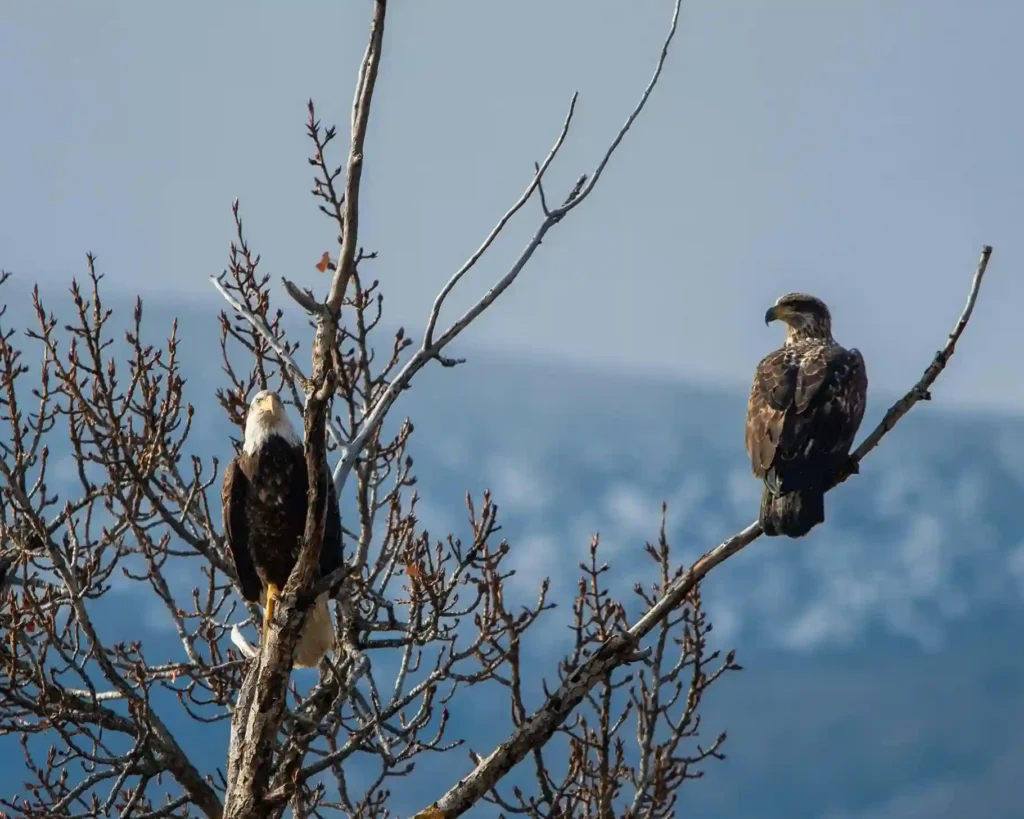Table of Contents
Eagles are a wonder to wildlife lovers, with their grand look and complex social lives. When discussing a Group of Eagles, we learn they’re not just solo hunters. Their group behavior shows us how they survive and thrive together.
Eagles face many challenges in the wild, needing to work together to survive. They have their own way of talking and teaming up, showing they’re smart and adaptable. This teamwork is key to their success.
Birdwatchers and scientists are curious about eagle groups. They see how eagles work together during hunts, defend their territory, and migrate. These behaviors show the complex social lives of these birds of prey.
From the bald eagle in North America to the golden eagle across continents, each has its own way of interacting. Learning about these group dynamics helps us see the amazing world of these birds that fly above us.
Understanding Eagle Gatherings in Nature
Eagles are amazing birds with complex social behaviors. They fascinate wildlife researchers. These birds are not always alone, unlike what many think.
The natural world shows how a Group of Eagles interacts and gathers. They come together for important reasons, including environmental needs and survival strategies.
Survival-Driven Social Interactions
Eagles gather when food is plentiful. Places with lots of fish or prey attract them. This is why they come together in certain areas.
Seasonal Migration Patterns
Seasonal changes lead to interesting eagle behaviors. During migration, they travel in groups. They share routes and protect each other.
Territorial Cooperation
Eagles are known for hunting alone, but they also show social complexity. They negotiate territory boundaries. They use visual and vocal signals to communicate.
What Is a Group of Eagles Called?

When bird lovers look into what’s an eagle’s group, they find a cool term: a “convocation” of eagles. This word shows the grandeur of these powerful birds. A group of eagles is more than birds flying together; it’s about strength, smarts, and teamwork.
The word “convocation” might seem fancy, but it fits how eagles act in the wild. Wildlife experts have seen eagles show amazing social skills. Even though not all eagles hang out in big groups, they do when hunting or migrating.
Different eagle types gather for different reasons. For example, bald eagles and golden eagles might team up during meals or when they’re looking for a mate. They might meet near good fishing spots or during their big migrations, showing their clever social ways.
The number of eagles in a group can change a lot. Some groups might have just a few birds, while others could have dozens. How many eagles gather depends on things like food, the weather, and what kind of eagle they are.
Learning about a group of eagles shows us how complex their social lives are. Their ability to gather shows their advanced communication and survival tactics in different places.
The Social Structure of Eagle Communities
Eagles are complex social creatures with fascinating group dynamics. They have sophisticated communication and social behaviors. These go beyond just hunting.
Female eagles, or hens, are key in family and territory management. They play a crucial role in eagle communities.
Hierarchy and Leadership
Eagle groups have a clear pecking order. This is based on age, strength, and breeding status. Dominant eagles control the best hunting spots and resources.
Young eagles must be careful to survive in these complex social networks.
Communication Strategies
Eagles use visual and vocal signals to communicate. Their calls mark territories, warn of threats, and plan hunts. Eaglets learn these skills from their parents early on.
Mating and Family Dynamics
Eagle families are very bonded. Mating pairs stay together for many seasons. They share in nest-building, hunting, and protecting their young.
This shows eagles have deep social connections. They are intelligent and cooperative predators with complex emotions and communication.
Different Species and Their Group Behaviors

Eagles are fascinating birds with unique social patterns. Researchers have found that different eagle species have different group behaviors. For example, the golden eagle and bald eagle in North America show different ways of interacting.
The bald eagle, a symbol of American wildlife, often gathers in large numbers in Alaska. These gatherings can have up to 300 eagles, showing how they work together to hunt. Golden eagles, on the other hand, usually stay alone unless it’s breeding season or when food is plentiful.
Tropical eagle species, like the harpy eagle, have even more complex group behaviors. These powerful birds rarely come together in large groups. They prefer to stay in dense rainforests, mostly interacting with their mates and family.
Studies show that where eagles live affects how they group together. Places like coastlines, mountains, and rivers influence their social structures. Knowing this helps experts track eagle populations and protect them.
The Role of Eagles in Various Ecosystems

Eagles are key to keeping ecosystems balanced in different habitats. As top predators, they play a vital role in nature. They help keep ecosystems healthy by working with local wildlife and the environment.
Hunting Patterns and Cooperation
Eagles are known for their smart hunting ways. They hunt together, showing off their teamwork. This teamwork helps them catch bigger prey and protect their territory.
Impact on Local Wildlife
Eagles control the numbers of smaller animals like rodents and fish. They keep these populations in check. This balance is crucial for a healthy ecosystem.
Environmental Significance
Eagles are important signs of a healthy environment. When eagle numbers are high, it means the ecosystem is doing well. Scientists study eagles to learn about the health of our planet.
Conclusion
Exploring the group of eagles shows us a world of complex social interactions. A group of eagles, known as a “convocation,” is more than just birds together. They have a network of survival strategies and ways to communicate, showing their ability to adapt in different places across North America.
But eagles are more than just hunters. They have complex social lives, with patterns in hunting, territorial fights, and family ties. Each type of eagle, like the Bald Eagle and the Golden Eagle, plays a key role in keeping nature in balance. They help keep the variety of wildlife healthy.
The way eagles act together is very important for nature. By studying their group behavior, scientists learn more about protecting wildlife and keeping ecosystems healthy. These birds are like messengers from nature, telling us about the health of our planet.
Looking into the lives of eagles shows us their amazing qualities. As top predators, they are strong, smart, and a symbol of the wild. They continue to fascinate scientists and nature lovers with their unique ways of living.












